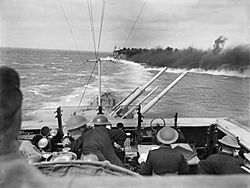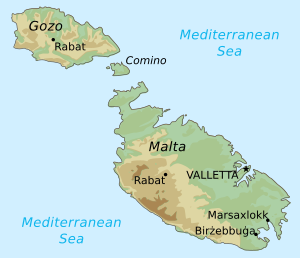Second Battle of Sirte facts for kids
Quick facts for kids Second Battle of Sirte |
|||||||
|---|---|---|---|---|---|---|---|
| Part of the Battle of the Mediterranean of Second World War | |||||||
 |
|||||||
|
|||||||
| Belligerents | |||||||
| Commanders and leaders | |||||||
| Philip Vian | Angelo Iachino | ||||||
| Strength | |||||||
| 4 light cruisers 1 anti-aircraft cruiser 18 destroyers 1 submarine |
1 battleship 2 heavy cruisers 1 light cruiser 10 destroyers 1 submarine |
||||||
| Casualties and losses | |||||||
| 39 killed 3 light cruisers damaged 2 destroyers disabled 3 destroyers damaged |
No casualties 1 battleship slightly damaged |
||||||
The Second Battle of Sirte was a big naval fight during Second World War. It happened on March 22, 1942, in the Mediterranean Sea, near the Gulf of Sidra. This battle was about a British convoy trying to deliver important supplies to Malta.
A "convoy" is a group of merchant ships traveling together, protected by warships. In this battle, British warships from the Royal Navy were protecting four supply ships. They faced a much stronger group of ships from the Italian Navy (called the Regia Marina).
Even though the British ships were outnumbered, they managed to hold off the Italian fleet. However, the battle caused delays. This delay meant the supply ships arrived in Malta later than planned. They were then attacked by enemy planes, and all four supply ships were sunk in the days that followed. One British destroyer was also lost.
Contents
Why This Battle Happened
Malta's Importance in the War
Malta is a small island in the Mediterranean Sea. During World War II, it was a very important base for the Allies (like Britain). From Malta, British planes and ships could attack enemy supply convoys. These convoys were carrying supplies for the Axis powers (like Italy and Germany) in North Africa.
Because Malta was so important, the Axis powers wanted to stop it. They bombed Malta heavily and tried to cut off its supplies. By early 1942, Malta was running low on food, fuel, and ammunition. It desperately needed supplies to keep fighting.
The British decided to send a new convoy, called MW10, to Malta. This convoy sailed from Alexandria, Egypt, on March 21, 1942. The British knew that Italian and German forces would try to stop it.
The British fleet in the eastern Mediterranean had some problems. In December 1941, two of their battleships were damaged by Italian frogmen. This left the British with only cruisers and destroyers to protect their convoys.
To help the MW10 convoy, the British tried a trick. They sent another group of ships from Gibraltar, pretending to be a convoy. This group included a battleship and aircraft carriers. However, this trick did not work, and the ships returned to port.
So, the MW10 convoy's protection relied heavily on smaller ships like destroyers and cruisers. Admiral Sir Philip Vian was in charge of the British warships protecting the convoy.
British Battle Plan
Admiral Vian knew his ships were weaker than the Italian fleet. So, he came up with a clever plan. He divided his ships into six groups. Five of these groups were ready to fight the enemy. The sixth group, led by the anti-aircraft cruiser Carlisle, would stay with the supply ships.
If the Italian fleet attacked, the first five groups would move forward to face the enemy. They would also create a huge smoke screen. A "smoke screen" is a wall of smoke that hides ships from the enemy. This smoke would make it hard for the Italian ships to see and hit the supply ships.
The main fighting ships would act as a "rearguard." This means they would fight at the back to delay the Italian Navy. Meanwhile, the Carlisle and other destroyers would continue to take the cargo ships safely to Malta.
The Battle Begins
On the afternoon of March 22, the British ships spotted the Italian fleet. At first, it was two Italian heavy cruisers and their destroyers. Admiral Vian immediately put his plan into action. The supply ships and their close escorts turned away to the south.
The British light cruisers and destroyers created a smoke screen and charged towards the Italians. After a short exchange of fire, the Italian cruisers pulled back. They were trying to trick the British into following them towards the main Italian fleet.
At 4:37 PM, the main Italian force appeared. It included the powerful battleship Littorio, a light cruiser, and many destroyers. The battle then raged for two and a half hours.
The British ships would quickly leave their smoke screen, fire a few shots, and then duck back into the smoke when Italian shells got too close. This made it very hard for the Italians to hit them.
Key Moments in the Fight
During the battle, the British destroyer Havock was badly damaged by a near-miss from the Italian battleship Littorio. She had to leave the fight.
Admiral Vian then sent his destroyers to launch torpedoes at the Italian ships. Torpedoes are underwater missiles. The British destroyers got as close as they could, about 5,000 yards (4,570 meters). None of the torpedoes hit their targets.
As the destroyer Kingston turned, she was hit hard by a shell. It went into her boiler room and started a fire, stopping her temporarily. The wind was strong and blowing towards the Italian ships. This helped the British lay their smoke screens effectively.
Another British destroyer, Lively, was hit by shell fragments. This caused some flooding but no one was hurt. The Italian battleship Littorio was hit by a small shell, but it caused very little damage.
As dusk approached, before 7:00 PM, the Italians gave up and turned back home. They did not have radar, which meant they would be at a big disadvantage fighting at night. The Italian fleet had more powerful guns, but they did not want to get too close. They were probably worried about the many torpedoes the British destroyers could launch.
After the Battle
Ships Involved
Here are some of the main ships that took part in the battle:
- Italian Navy
- One battleship: Littorio
- Two heavy cruisers: Gorizia, Trento
- One light cruiser: Giovanni delle Bande Nere
- Many destroyers, including Scirocco and Lanciere (which later sank in a storm).
- British Royal Navy
- Four light cruisers: HMS Dido, Euryalus, Cleopatra, Penelope
- One anti-aircraft cruiser: HMS Carlisle
- Many destroyers, including HMS Jervis, Kipling, Kingston, Havock, and Lively.
- Merchant Ships (all sunk later)
- Clan Campbell
- Breconshire
- Pampas
- Talabot
Damage to Ships
The British cruiser HMS Cleopatra was hit on its bridge. Sixteen sailors were killed. Other cruisers, Euryalus and Penelope, were also damaged.
The destroyer Kingston was hit in the middle by a shell from the battleship Littorio. Fifteen men on board were killed. The ship was stopped, and parts of it were destroyed. Even with a fire and a flooded boiler, Kingston managed to get moving again and reached Malta the next day.
Havock was also badly damaged by a near-miss from Littorio. Eight sailors died. Lively had to go to Tobruk for repairs after shell fragments from Littorio hit her hull.
The Italian fleet fired over 1,500 shells at the British ships. The British cruisers fired over 1,500 shells back, and their destroyers fired about 1,300 shells and 38 torpedoes. Enemy planes also attacked the convoy during the battle.
What Happened Next
Most of the British warships, low on fuel and ammunition, turned back to Alexandria. The damaged destroyers and the four supply ships continued towards Malta.
The next day, these ships faced constant air attacks. The supply ship Clan Campbell was sunk close to Malta. The oil tanker Breconshire was too damaged to reach the main harbor.
Two other merchant ships, Talabot and Pampas, reached Malta's Grand Harbour almost unharmed. However, on March 26, German dive bombers attacked them. All three remaining supply ships—Talabot, Pampas, and Breconshire—were sunk by March 27. Only about 5,000 tons of supplies were unloaded from the 26,000 tons that had been loaded.
The Italian fleet also had problems after the battle. On their way back to base, a severe storm sank two of their destroyers, Scirocco and Lanciere.
The British destroyer Kingston, which was being repaired in Malta, was attacked by German planes a few days later. She was damaged so badly that she could not be repaired and was later scrapped.
Another damaged destroyer, Havock, was ordered to Gibraltar. But on April 6, she ran aground (hit the bottom) off Tunisia and was wrecked. Two crew members died.
Images for kids



